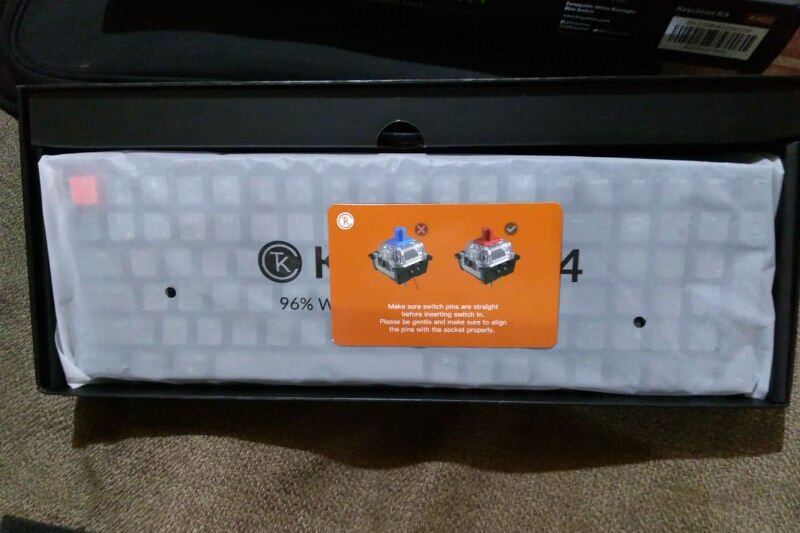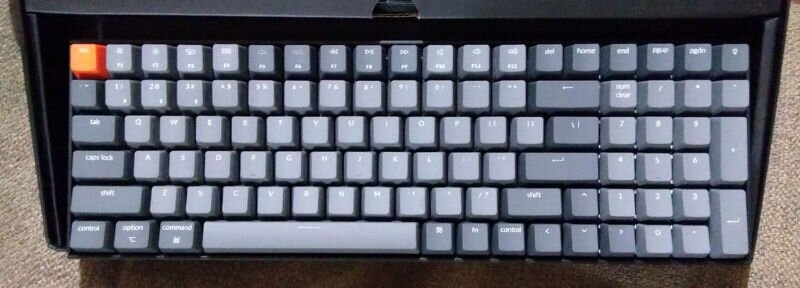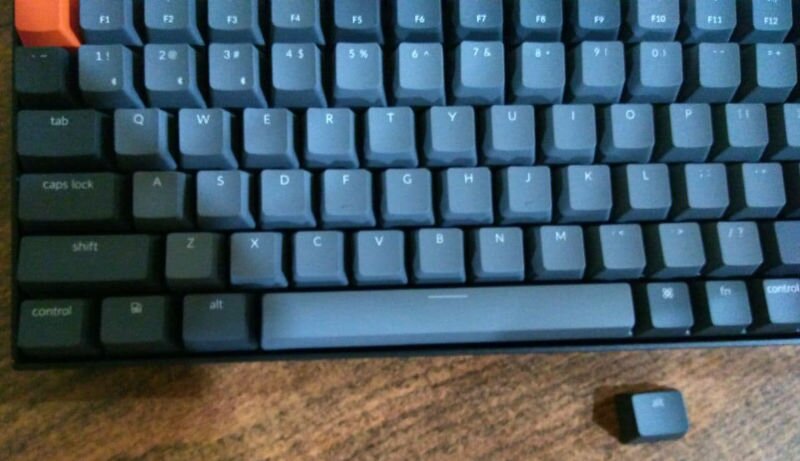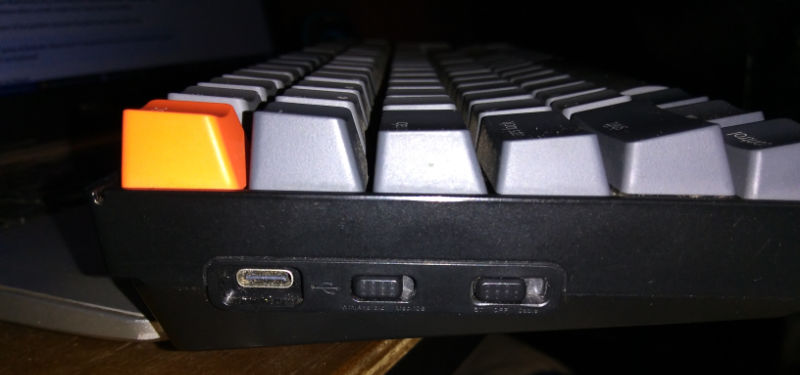
Back in mid 2019, I was on the market for a new laptop. My old laptop was plagued by issues that, while farily minor, where a deal breaker for me. Thus, I got a shiny new Dell laptop which seemed to fit the bill just right. And it did… mostly.
This is the fourth in a TestyTim.com series of reviews on mechanical keyboards. You can read more in the review series overview.
Now, I work as an attorney (sometimes) and as a translator (most of the time); and I also teach at the university level. All these lines of work have something in common: they involve a lot of writing. I could be churning thousands and thousands of words at some time. Thus, getting a good keyboard is critical for me.
I thought I got that covered. At the office I have a generic “gamer” mechanical keyboard. It’s over the top in its aesthetics, and has a lot of flashy RGB LED lighting options that I don’t care for, but it gets the job done and that’s the important part.
Enter 2020 and the pandemic. Most work I had to do was from home, and that meant using my laptop. Thus, that poor Dell laptop’s keyboard got quite a beating. Again, I wrote thousands and thousands of words as part of my daily job. The laptop soldiered on, but at some moment the keyboard began to act up. Specifically, the left Ctrl key and the Spacebar began to be unresponsive. This led to several issues for me, such as having documents with some extra ’s’ letters scattered (because I thought I was saving my work, but that left Ctrl key didn’t work). Having such errors in documents as important as legal briefs (for example), and having to allocate additional time and effort for proofreading was not worth it. What could I do? I considered my options.
I could have ordered a keyboard part for my laptop, but this had two things going against it: 1) Any keyboard I would use would have to endure heavy usage, and this particular laptop showed that its keyboard was not up to the task; and 2) I already replaced my previous laptop’s keyboard. While it ultimately worked, it was a difficult task. The keyboard is placed at the very bottom of the stack of laptop’s boards and components, and disassembling and assembling them is quite the effort, and very delicate work. I didn’t want to repeat the experience.
So, what’s a typist to do in such cases? Seek an external keyboard, of course. Now, I had a laundry list of features that were ideal or desirable for such keyboard:
So, I begain my keyboard hunting. On the one hand, there’s the gold standard in mechanical keyboards: Unicomp, the sucessors of the mighty IBM Model M keyboard. But they do not have a wireless model, and no compact design either (at least, no laptop-level of compactness). I love Unicomp keyboards but I had to look elsewhere.
And elsewere there was the Sea of TKL Keyboards. Everyone and their cousin fell all over themselves offering all kinds of TKL keyboards, so there was no keypad. I almost despaired of finding anything suitable for my needs… until someone suggested me to take a look to the Keychron K4 keyboard. Sure enough, suddenly there was a keyboard which seemingly fulfilled all my requirements. Would it be a good fit in real life? Let’s see.
The Keychron K4 mechanical keyboard (manufacturer - Amazon link) is now at its version 2 and it sells for a price between USD 69.99 to 99.00 depending on the configuration. This is what the manufacturer (and the mechanical keyboard scene) call a 96% keyboard. It is a keyboard layout which offers the following features:
The switches offered are Gateron Pro, and you have a choice of Gateron Pro Red, Brown or Blue switches. The keyboard is wireless with Bluetooth conectivity and a 4000 mAh battery which would ensure a long lasting wireless operation. It also can be connected via a wired connector; to that effect the keyboard has an USB-C connector and a USB-C to USB-A charging cable.
You can get a white backlight or a RGB gamer-type option. The RGB-backlit model can additionally come with an aluminum frame which supposedly is sturdier. As for the keyboard proper, you can order it with soldiered-on (cheaper) or hot-swappable (pricier) switches.
I decided on a white backlit. The RGB version was unnecessary and too over the top for me, and excessively tacky, for starters. That limited me to a plastic-only frame. This could be seen as a disadvantage, but my plastic-frame keyboard feels very sturdy and solid, so it’s really not an issue. As for the switches, I quickly decided on the Blue switches. I need feedback, and I work alone, so any noise would not be a distraction for anyone. Another no-brainer choice was to have a hot-swappable version. I had some mechanical keyboards with soldered switches, ruined by two or three non-working switches, so this time I wanted something which could be easily fixed should the need arise.
I initially wanted to buy on Amazon, but this particular configuration was unavailable at the time, so I purchased the keyboard from the manufacturer. As configured, the keyboard sold for USD 79.99, plus USD 20.00 for shipping within continental USA via DHL. The shopping experience went as expected, and in due time the keyboard arrived in Asunción.

Sure enough, the keyboard manages to be compact, with its dimensions listed as 371 x 124 x 38 mm. In this department, the keyboards delivers and does it well. It is slightly shorter than my 15.6” laptop length so, despite being a 96% keyboard, it can still fit well in space-constrained environments. Many reviews pointed out that the keyboard heigh would require an ergonomic palm rest, and surely Keychron can sell you one of those, but I personally found that unnecessary.

Figure 2 shows the keyboard layout coming from the factory. As you can see, the keys are set for a Mac keyboard. Keychron makes good keyboards, but their folks are terminally infected with the Cupertino pest (one of the keycap sets they sell even has its Enter key inscribed with “one more thing”, so you can get an idea of how deep they are into it). They supposedly compensate for such a less than brilliant thinking by providing a keycap removal tool and alternate keycaps for a PC layout. Yes, you read me right: they expect the majority of their potential market to do “some assembly” right out of the box because they are victims of the Reality Distortion Field.
Here I ran into a quality issue. To Keychron’s credit, they ship the keyboards, as I said, with PC alternate keycaps and a keycap removal tool. Using the tool makes the process for keycap sustitution easy enough. As seen from Figure 2, there are left and right Command keys which should be changed for Alt keys in a PC layout. I got my keyboard with a set of PC keycaps which had two left Alt keys instead of a left and a right one. I changed the left Command key; but the right Command key stayed with me because Keychron did not ship the right Alt key.

The box comes with the keyboard, the PC replacement keycaps, a keycap removal tool, a quick setup card, an extremely barebones instruction leaflet, and a switch removal tool (because I ordered the hotswappable version), and a connecting USB-C — USB-A cable. A pretty decent and good enough package, save for the documentation. I understand that right now manufacturers print as little documentation as possible to save costs. But finding information for Keychron keyboards can be frustrating. I had a keycap removal tool and PC keycaps which needed to be exchanged with their Mac counterparts. But no instructions whatsoever on how to do it. There also was the switch removal tool; something which I had no idea at all what was for. And there was no documentation whatsoever telling me about these tools and their usage in the package, and also finding online information on them wasn’t easy.

This is inexcusable. A good product should come with good documents. Not necessarily printed documents. Keychron can keep providing a barebones essential leaflet/tiny user manual but they can provide an online wiki/manual with clear instructions. Why should the user has to figure it out all by himself?
Figure 4 shows the left side of the keyboard, with its USB-C connector and two switches: One to switch between Android / Windows and Mac / iOS modes; and a power switch with three positions: the left for using the keyboard as a Bluetooth device, the right to use the keyboard as a wired device (with its USB-C to USB-A connector cable) and the middle position for power off. The switches are small. While this is not much of a problem for the Windows / Mac mode switch, it is, and very much so, for the power switch. It is very hard to place the switch in the middle (power off) position. Either the switch could not be moved or the force applied makes it go the full two positions instead of stopping at the middle. And it is so tiny that I cannot use my index/thumb fingers to control the switch travel.
Keychron’s 96% layout works surprisingly well, although there are some significant drawbacks. The placement of some keys feel cramped and surely there were a lot of mistypes and “mispresses”, thus adding to the keyboard’s learning curve. For example, a lot of times when I wanted to press the Up Arrow key I ended up pressing the 1 keypad key. This, however frustrating, was expected due to the layout. There are another minor drawbacks, such as a lack of an Insert key. Perhaps this might be considered useless to youngsters, but for us old fools it is essential for some copy-paste operations (this worked right from the early days of MS Windows, and also is the best way to paste text into a Unix terminal window). But Insert can be used by pressing Fn + Del, so it’s not a big deal. A bigger nuisance, in my opinion, is the small size of the Numpad 0, now demoted to a regular keycap instead of the double-size keycap it is normally. I lost count of how many times I hit the Right Arrow key instead of the zero due to that. There are nice details, though, such as special activation lights for Caps Lock and Num Lock, which are really useful.

But there are additional design fails which are not as apparent. At the top right corner, there is a “lightbulb” key. With that key you can switch between the various backlight (white or RGB) modes. Why there is such a dedicated key for that? Every time I accidentally brush that key, the backlight mode changes and I have to cycle again and again between modes to get my backlight mode back. And don’t get me started on the times I hit that key accidentally while trying to hit the Numpad (-) key! This could have been easily solved by making the backlight pattern switching a combination of a Fn + key shortcut. Again, why give it a dedicated key? That key slot could have been put to a much better use. For example, a regular Insert key. Just sayin’…
The factory-supplied keycaps are good enough, although as Editor-in-Chief Tim Butler has said in his Keychron K2 review, the ABS keycaps are thin, feel hollow and cheap. They have all the tactile marks expected in the F, J, and Numeric 5 as expected. But they could be better. And here’s another issue which shows Keychron’s passions and interests, but also signal an overall lack of understanding of basic ergonomic principles. Tim likes the keycap typography of his K2; I respect that. But in my K4, while similar, the keycap label design is atrocious. You see, I’m not a youngster like Tim, and I have to use reading glasses. Now go back to Figure 2 and check some keys, such as the keys right of the L, M and 0 keys. The keycap label design might be aesthetically pleasing but oh my, they are positively microscopic. Sometimes I type from my sofa, with my big screen TV, at a comfortable distance, mirrors my laptop screen. In that way I could type without the need of glasses … but Keychron felt all hipster and cool and made its keycaps hideously small. To that, add the low contrast between the keycap label and the keycap grey color, and you have a compound of issues. It’s just frustrating seeing such a great product marred by almost elemental ergonomy blunders.
The first row of keys, the function row, has the usual F1-F12 keys which double as special function keys. The layout of these function keys is that of (surprise!) the Mac keyboard. Once in operation, the keyboard works well and as expected on Windows 10; I also was able to use it successfully with Windows 11. But my core requirement was for the keyboard to be compatible with my main desktop operating system, GNU/Linux. I use Slackware 64 current as my distribution, and since it makes a point of not modifying the upstream sources, it usually has great hardware compatibility. Well, the keyboard worked on Linux but only after significant configuration efforts. I ran into the issues described by Bastian Venthur on his Keychron keyboard. Initially, the keyboard only worked with the special function keys activated, and no keyboard shortcut or sequence or configuration could make it return the standard F1-F12 codes. Keychron says that we could go to a “Facebook Keychron Linux Users’ Group”. I had to create a file in /etc/modprobe.d named hid_aple.conf where I had to put this line:
options hid_apple fnmode=2
Yes, you read that right. In order for this keyboard to work properly, I had to pass a parameter to a Linux kernel module. Keychron can get enough code in its keyboards’ ROM for a zillion complicated LED animation patterns but they can’t be bothered to make their keyboards work properly on Linux? This is a serious fault. Something must be seriously amiss on a manufacturer for a peripheral as basic as a keyboard to require fiddling with kernel modules in order for it work properly.
As stated previously, the keyboard can work on both wired and wireless modes. I generally use the keyboard wirelessly, via Bluetooth, while the wired use is reserved for the occassions when the battery needs recharging. Keychron helpfully offers three different Bluetooth slots for the keyboard; I use the first for GNU/Linux, the second one for Windows, and a third one is still available for whatever use I might come up. Switching between different slots is generally painless but requires a power cycle, with the drawbacks of that wretched three-position switch on the left side. The Bluetooth pairing on Linux works very well with Bluez 5.63, although I find that pairing sometimes takes more attempts than with Windows. The 4000 mAh battery works well and the battery life works as expected. After over three months of continuous usage, battery life varies from 10 to 18 days, making the keyboard comfortable to use wirelessly. The battery life is a nice touch in this keyboard. What’s not so nice is that Bluetooth does not reliable report the battery status, and thee’s no way to know whether the battery levels are low (I’ve been told that Fn+B does it, but in my particular model it doesn’t). So the keyboard works under Bluetooth until it doesn’t, sometimes in the middle of a word. Annoying.
The supplied Gateron Pro Blue switches tend to work well and provide a pleasant typing experience, with a nice (if somewhat soft) clicky sound. You can listen to a recording I made of the keyboard sound here. After two and a half months of merciless beating, the switches soldier on, except the B key which began to act up, sometimes failing to register a keypress. But the issue went away; maybe it was all a product of the dust of the environment.
Update: While this article was being in process of publication, I accidentally let the keyboard slip through my lap and it fell in an angle to the floor, making a loud noise. Honoring its sturdy aspect, the keyboard was not affected at all… Well, mostly. The ‘M’ key began to be unresponsive, and I had to get back to work pronto. Clients are not especially understanding or accomodating with deadlines in my line of work. Thankfully I ordered a keyboard with hotswappable switches. So I removed the keycaps, then proceeded to remove the switch for the ‘M’ key. It looked all right save for one of the copper contacts wich seemd to be shortened or broke. Then I removed the keycap and the switch for that wretched ‘lightbulb key’. Next, I swapped switches: the good ‘lightbulb’ one on the ‘M’ key; and the former ‘M’ key on the lightbulb key.
Result: I have a working keyboard again, with the added bonus of getting that stupid lightbulb key permanently disabled. In hindsight, looks like those Gateron Blue switches aren’t as sturdy as the rest of the keyboard, so beware and tread lightly. And, by all means, should you get one of these, do yourself a favor and get yourself a hotswappable one. Now I’m happy as a clam since that lightbulb key stopped giving me grief, but Keychron folks should be thinking long hard on why they thought they could get away with such an annoyance.
So, what to make of this keyboard?
Well, there are a lot of disappointments with it, for starters. There is a fanatical devotion to Mac platforms to the literal detriment of all others. Providing Mac keycaps as default and forcing the users of other platforms to tinker with the keycaps does not sound very attractive to say the least. There are some quality issues, such as the wrong Alt keycap I received. And while the product is obviously built with quality, there are ergonomic oversights which greatly hamper the user experience: the switch at the left, the difficult reading in the keycap labels, the not so bright presence and placement of the lightbulb key. The documentation is abysmal to say the least; you have to figure out a lot of things on your own through trial and error. To this I should add the atrocious requirement to tinker with kernel modules in order for the keyboard to work properly under GNU/Linux.
However, on the other hand, this is a great little mechanical keyboard built with good quality, at a reasonable price, of a compact size and yet offering a full keypad; with great wireless performance under both Windows 10/11 and GNU/Linux. And once you got it working under GNU/Linux, it works, as in workhorse. With all its flaws and drawbacks, some of them significant, the Keychron K4 V2 keyboard is a great keyboard and an answer to many a typists’ needs (Keychron, $79 as tested)

Eduardo Sanchez is a contributing editor and senior international correspondent to Open for Business. Eduardo’s background includes studies in theology and law; he also has a great appreciation for Renaissance sacred music. He resides with his wife, Gloria, in Asunción, Paraguay (South America).
You need to be logged in if you wish to comment on this article. Sign in or sign up here.
Join the Conversation
Re: Keychron K4 v2
Such a great insight into this keyboard, Eduardo. Other than your misunderstanding about the wonders of the Mac, that is… I think you are right about the contrast on the keycaps on this board versus the K2 v2.
I think you are right about the contrast on the keycaps on this board versus the K2 v2.